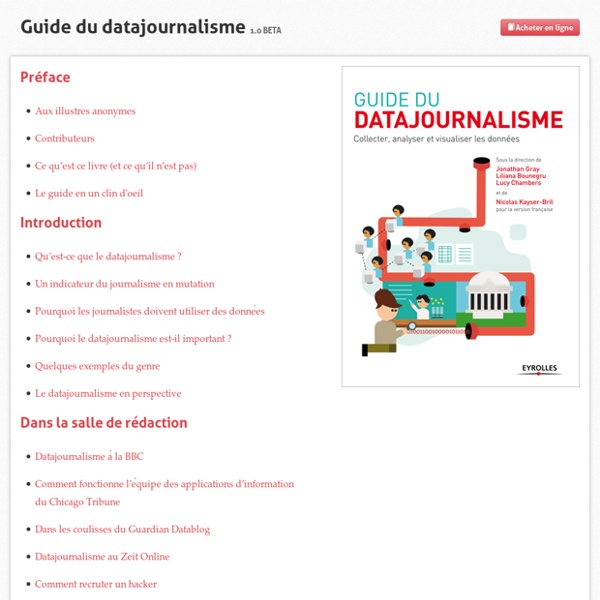



http://jplusplus.github.io/guide-du-datajournalisme/
Related: Education aux médias et à l'informationWhen Data Tell Stories Last April, the International Consortium of Investigative Journalists (ICIJ) revealed one of the greatest data leaks obtained and analysed to date by any media outlet. “Offshore Leaks” is a vast multimedia report that exposes the networks of businesses, politicians, fundraisers and celebrities from all over the world that use companies and trusts in offshore tax havens. Through the use of maps, videos and infographics, readers are able to understand the web of connections and their millionaire money transactions over the course of the years. However, to be able to present this macro-project that exposes the tax havens, the ICIJ had 86 journalists from 46 countries working for a year and a half, managing a total of 260 gigabytes of data. Biological Imaging - Morphbank Morphbank :: Biological Imaging is a continuously growing database of images that scientists use for international collaboration, research and education. Images deposited in Morphbank :: Biological Imaging document a wide variety of research including: specimen-based research in comparative anatomy, morphological phylogenetics, taxonomy and related fields focused on increasing our knowledge about biodiversity. The project receives its main funding from the Biological Databases and Informatics program of the National Science Foundation (Grant DBI-0446224). Morphbank :: Biological Imaging was established in 1998 by a Swedish-Spanish-American group of entomologists and is currently housed at the School of Computational Science (SCS) at Florida State University.
Data journalism at the Guardian: what is it and how do we do it? Data journalism. What is it and how is it changing? Photograph: Alamy Here's an interesting thing: data journalism is becoming part of the establishment. Numerical Data Search You are seeing the early beta version of Zanran. We will be delighted for any comment. or suggestions. Gushing and excessive praise is always welcome. Contact us For ideas and suggestions, please email us: helpdesk [at] zanran [dot] com. We will attempt to reply to all (sensible) emails within 2 working days.
The inverted pyramid of data journalism I’ve been working for some time on picking apart the many processes which make up what we call data journalism. Indeed, if you read the chapter on data journalism (blogged draft) in my Online Journalism Handbook, or seen me speak on the subject, you’ll have seen my previous diagram that tries to explain those processes. I’ve now revised that considerably, and what I’ve come up with bears some explanation. I’ve cheekily called it the inverted pyramid of data journalism, partly because it begins with a large amount of information which becomes increasingly focused as you drill down into it until you reach the point of communicating the results.
1.0 (stable) Time to celebrate :-) Today, Docear 1.0 (stable) is finally available for Windows, Mac, and Linux to download. It’s been almost two years since we released the first private Alpha of Docear and we are really proud of what we accomplished since then. ODLIS — Online Dictionary for Library and Information Science In classification, one of the distinguishing characteristics of a class, identified as a means of differentiating it from other classes. As defined in FRBR (Functional Requirements for Bibliographic Records), one of a set of characteristics enabling users of information to formulate queries and evaluate responses when searching for information about a specific entity. Attributes can be inherent in the entity (physical characteristics, labeling information, etc.) or supplied by an external agent (assigned identifiers, contextual information, etc.). For example, the logical attributes of a creative work include its title, form, date of creation, intended audience, etc. As a general rule, a given instance of an entity exhibits a single value for each attribute, but multiple values are possible (a work may be published under more than one title or in more than one form), or a value may change over time (date of publication for serials).
Introduction - Codex canadensis Archived Content This archived Web page remains online for reference, research or recordkeeping purposes. This page will not be altered or updated. Web pages that are archived on the Internet are not subject to the Government of Canada Web Standards. As per the Communications Policy of the Government of Canada, you can request alternate formats of this page on the Contact Us page.